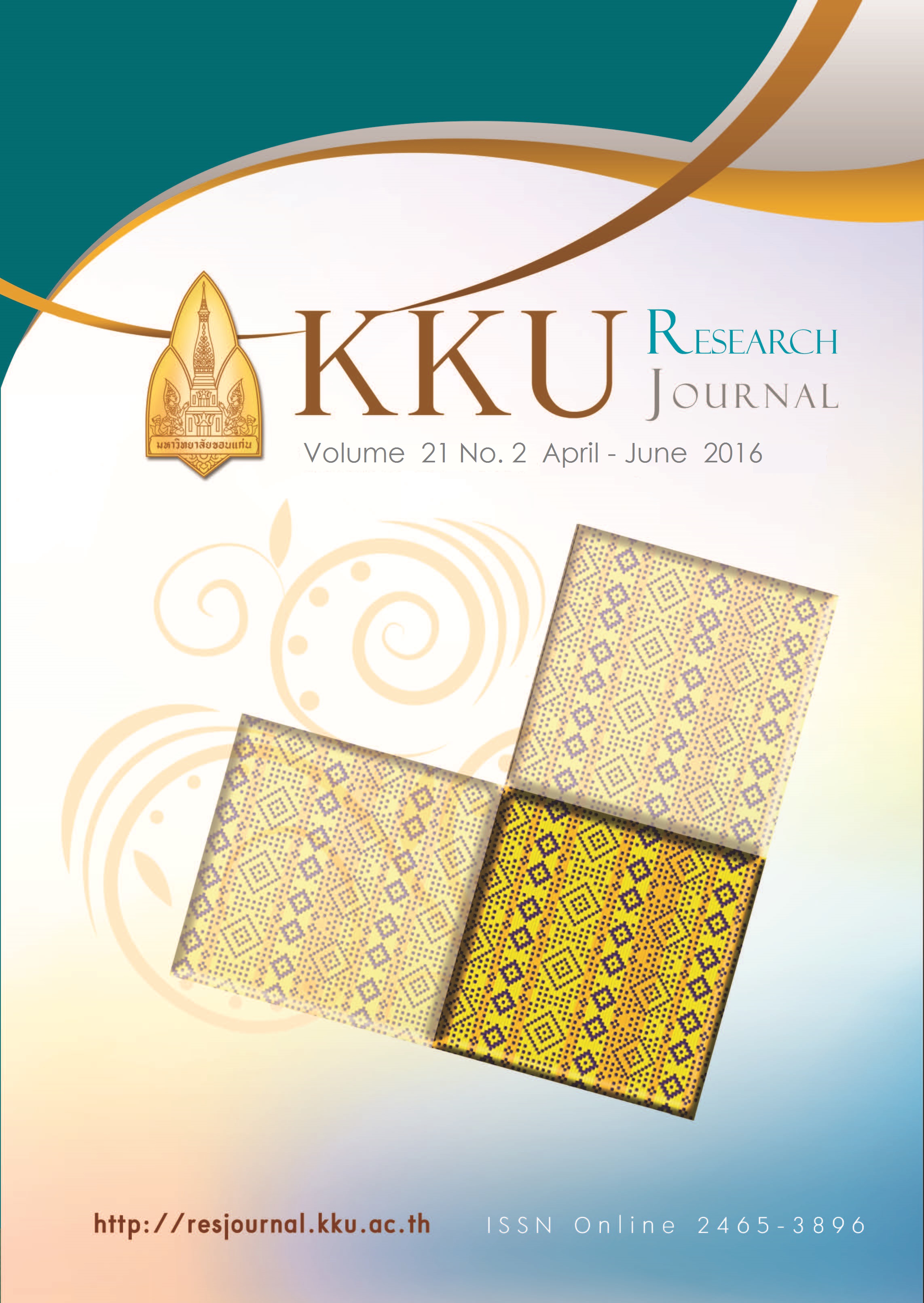Exobiopolymer production of Phytocordyceps sp. BCC 2744 and Akanthomyces pistillariiformis BCC 2694; optimization and scale-up
Main Article Content
Abstract
Production of exobiopolymers by Phytocordyceps sp. BCC 2744 and Akanthomyces pistillariiformis BCC 2694, interleukin-8 (IL-8) inducers, were optimized using experimental design. Biological and physiological properties of these exobiopolymers are attractive to use as wound-dressing material, so that it is very interesting to increase its production. Phytocordyceps sp. BCC 2744 and Akanthomyces pistillariiformis BCC 2694 were cultivated on different carbon and nitrogen sources and the best carbon and nitrogen sources for exobiopolymer production of Phytocordyceps sp. BCC 2744 were glucose and peptone, respectively, and 0.88 g/L exobiopolymer was obtained. Higher exobiopolymer (1.82 g/L) was obtained on glucose and meat extract by Akanthomyces pistillariiformis BCC 2694. After the effects of 4 variables were studied using a two-level fractional design, glucose and peptone concentration were the most influential parameters on exobiopolymer production of Phytocordyceps sp. BCC 2744. Lower exobiopolymer production was obtained in the medium supplemented with 5-Fluorouracil and vitamin solution at high level (10 mM and 3mL/L, respectively). The highest exobiopolymer production was obtained on 60 g/L glucose and 20 g/L peptone and 2.32 g/L exobiopolymer was produced. About 4.0 g/L exobiopolymer production in a 20 L bioreactor was obtained. At least 4 variables; medium type, nitrogen sources, glucose, and nitrogen concentration were applied on a two-level factorial design of biomass and exobiopolymer production of Akanthomyces pistillariiformis BCC 2694. Models obtained from the multiple regression are significant. At high level of glucose (60 g/L), phosphate medium, and 20 g/L meat extract, higher exobiopolymer production and about 2.54 g/L was obtained. About 4.5 g/L exobiopolymer production in 20 L bioreactor was obtained.
Article Details
References
[2] Carbonero E., Sassaki G., Stuelp P., Gorin P., Woranovicz-Barreira S., and Iacomini M. 2001 Comparative studies of the polysaccharides isolated from lichenized fungi of the genus Cladonia: significance as chemotypes. FEMS Microbiol Lett. 2001;94:65.
[3] Chen, W., Zhao, Z., Chen S. F., Li, Y. Q. Optimization for the production of exopolysaccharide from Fomes fomentarius in submerged culture and its antitumor effect in vitro. Bioresour Technol. 2008; 99(8):3187-94.
[4] Cui J., and Chisti Y. Polysaccharopeptides of Coriolus versicolor: physiological activity, uses, and production. Biotechnol Adv. 2003;21(2): 109-22.
[5] Kim, S. W., Hwang, H. J., Park, J. P., Cho, Y. J., Song, C. H., and Yun, J. W. Mycelial growth and
exobiopolymer production by submerged culture of various edible mushrooms under different media. Lett Appl Microbio. 2002a;34:56-61.
[6] Kim, S. W., Hwang, H. J., Xu, C. P., Na, Y. S., Song, S. K., and Yun, J. W. Influence of nutritional conditions on the mycelial growth and exopolysaccharide production in Paecilomyces sinclairii. Lett Appl Micorbio. 2002b;34:389-393.
[7] Kim, S. W., Hwang, H. J., Xu, C. P., Sung, J. M., Choi, J. W., and Yun, J. W. Optimization of submerged culture process for the production of mycelial biomass and exo-polysaccharides by Cordyceps militaris C738. J Appl Microbio. 2003a;94:120-126.
[8] Kim SW, Xu CP, Hwang HJ, Choi JW, Kim CW, Yun JW. Production and characterization of exopolysaccharides from an enthomopathogenic fungus Cordyceps militaris NG3. Biotechnol Prog. 2003b;19: 428-35.
[9] Kim S.W., Hwang, H. J., Xu, C. P., Choi, J. W., and Yun, J. W. Effect of aeration and agitation on the production of mycelial biomass and exopolysaccharides in an enthomopathogenic fungus Paecilomyces sinclairii. Lett Appl Microbio. 2003c;36:321-326.
[10] Kim, H. M. , Park, M. .K., and Yun, J. W. Culture pH affects exopolysaccharide production in submerged mycelial culture of Ganoderma lucidum. Appl Biochem Biotechnol. 2006;134: 249-62.
[11] Kremer, P., Novotny, C., Marais, M. F., and Joseleau, J. P. Structure of extracellular polysaccharide produced by lignin-degrading fungus Phlebia radiata in liquid culture. Biol Macromol. 1999;24: 61-64.
[12] Madla, S., Methacanon, P., Prasitsil, M., and Kirtikara, K. Characterization of biocompatible fungi-derived polymers that induce IL-8 production. Carbohydr Polym. 2005;59 (3):275-280.
[13] McNeely, W. H. and Kang, K. S. Xanthan and other biosynthetic gums. In Industrial Gums. (Ed. By Whistler, R. L. and BeMiller, J. N.) New York, Academic Press, 1973;473-497.
[14] Methacanon, P., Madla, S., Kirtikara, K., and Prasitsil, M. Structural elucidation of bioactive fungi-derived polymers. Carbohydr Polym. 2005;60:199–203.
[15] Park, J. P., Kim, S. W., Hwang, H. J., and Yun, J. W. Optimization of submerged culture condition for the mycelial growth and exobiopolymer production by Cordyceps militaris. Lett Appl Microbio. 2001;33:76-81.
[16] Park, P. J., Kim, Y. M., Kim, S. W., Hwang, H. J., Cho, Y. J., Lee, Y. S., Song, C. H., and Yun, J. W. Effect of aeration rate on the mycelial morphology and exo-biopolymer production in Cordyceps militaris. Proc Biochem. 2002;37:1257-1262.
[17] Park, P. J., Kim, Y. M., Kim, S. W., Hwang, H. J., Cho, Y. J., Lee, Y. S., Song, C. H., and Yun, J. W. Effect of agitation intensity on the exo- biopolymer production and mycelial morphology in Cordyceps militaris. Lett Appl Microbio. 2002;34:433-438.
[18] Peng, Y., Zhang, L., Zeng, F., and Xu, Y. 2003. Structure and antitumor activity of extracellular polysaccharides from mycelium. Carbohydr Polym. 2003;54: 297-303.
[19] Su P., Henriksson A., and Mitchell H. Selected prebiotics support the growth of probiotic mono-cultures in vitro. Anaerobe. 2007;13 (3-4):134-9.
[20] Tang, Y. J. and Zhong, J. J. Exopolysaccharide biosynthesis and related enzyme activities of the medicinal fungus, Ganoderma lucidum, grown on lactose in a bioreactor. Biotech lett. 2002;24:1023-1026.
[21] Xu, C. P., Sinha, J., Bae, J. T., Kim, S. W., and Yun, J. W. Optimization of physical parameters for exo-biopolymer production in submerged mycelial cultures of two entomopathogenic fungi Paecilomyces japonica and Paecilomyces tenuipes. Lett Appl Microbiol. 2006;42(5):501-6.
[22] Xu, C. P., Kim, S. W., Hwang, H. J., Choi, J. W., and Yun, K. W. 2003. Optimization of submerged culture
conditions for mycelial growth and exo-biopolymer production by Paecilomyces tenuipes C240. Proc Biochem. 2003;38:1025-1030.
[23] Yaman, A. Alternative methods of terminal sterilization for biologically active macromolecules. Curr Opin Drug Discov Devel. 2001;4(6): 760-763.


